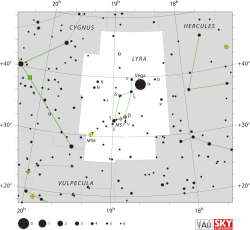Lyra
| Constellation | |

|
|
| Abbreviation | Lyr |
|---|---|
| Genitive | Lyrae |
| Pronunciation | /ˈlaɪərə/, genitive /ˈlaɪəriː/ |
| Symbolism | Lyre, harp |
| Right ascension | 18h 14m to 19h 28m |
| Declination | 25.66° to 47.71° |
| Family | Hercules |
| Quadrant | NQ4 |
| Area | 286 sq. deg. (52nd) |
| Main stars | 5 |
|
Bayer/Flamsteed stars |
25 |
| Stars brighter than 3.00m | 1 |
| Stars within 10.00 pc (32.62 ly) | 3 |
| Brightest star | Vega (α Lyr) (0.03m) |
| Nearest star | Vega (25.04 ly, 7.68 pc) |
| Messier objects | 2 |
| Meteor showers |
Lyrids June Lyrids Alpha Lyrids |
| Bordering constellations |
Draco Hercules Vulpecula Cygnus |
|
Visible at latitudes between +90° and −40°. Best visible at 21:00 (9 p.m.) during the month of August. |
|
Lyra (/ˈlaɪərə/; Latin for lyre, from Greek λύρα) is a small constellation. It is one of 48 listed by the 2nd century astronomer Ptolemy, and is one of the 88 constellations recognized by the International Astronomical Union. Lyra was often represented on star maps as a vulture or an eagle carrying a lyre, and hence sometimes referred to as Aquila Cadens or Vultur Cadens. Beginning at the north, Lyra is bordered by Draco, Hercules, Vulpecula, and Cygnus. Lyra is visible from the northern hemisphere from spring through autumn, and nearly overhead, in temperate latitudes, during the summer months. From the southern hemisphere, it is visible low in the northern sky during the winter months.
Vega, Lyra's brightest star is one of the brightest stars in the night sky, and forms a corner of the famed Summer Triangle asterism. Beta Lyrae is the prototype of a class of stars known as Beta Lyrae variables. These binary stars are so close to each other that they become egg-shaped and material flows from one to the other. Epsilon Lyrae, known informally as the Double Double, is a complex multiple star system. Lyra also hosts the Ring Nebula, the second-discovered and best-known planetary nebula.
...
Wikipedia
